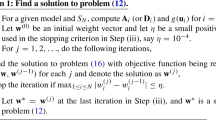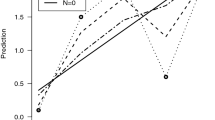Abstract
The usual estimators of the regression under isotonicity assumptions are too sensitive at the tails. In order to avoid this problem, some new strategies for fixed designs are analyzed. The uniform consistency of certain estimators on a closed and bounded working interval are obtained. It is shown that the usual isotonic regression can be employed when the number of observations at the edges of the interval is suitably controlled. Moreover, two modifications are proposed which substantially improve the results. One modification is based on the reallocation of part of the edge observations, and the other one forces the isotonic regression to take values within some horizontal bands. The theoretical results are complemented with some examples and simulation studies that illustrate the performance of the proposed estimators in practice.










Similar content being viewed by others
References
Alvarez E, Yohai V (2012) M-estimators for isotonic regression. J Stat Plan Inference 142:2351–2368
Ayer M, Brunk HD, Ewing WT, Reid WT, Silverman E (1955) An empirical distribution function for sampling with incomplete information. Ann Math Stat 26:641–647
Barlow RE, Bartholomew D, Bremner JM, Brunk HD (1972) Statistical inference under order restrictions: the theory and applications of isotonic regression. Wiley, New York
Brunk HD (1970) Nonparametric techniques in statistical inference, chap. estimation of isotonic regression. Cambridge University Press, London, pp 177–195
Colubi A, Domínguez-Menchero JS, González-Rodríguez G (2006) Testing constancy for isotonic regressions. Scand J Stat 33:463–475
Colubi A, Domínguez-Menchero JS, González-Rodríguez G (2007) A test for constancy of isotonic regressions using the \({L}_2\)-norm. Stat Sin 17:713–724
Cuesta-Albertos JA, Domínguez-Menchero JS, Matrán C (1995) Consistency of \({L}_p\)-best monotone approximations. J Stat Plan Inference 47:295–318
de Leeuw J, Hornik K, Mair P (2009) Isotone optimization in R: pool-adjacent-violators algorithm (PAVA) and active set methods. J Stat Softw 32:1–24
Domínguez-Menchero JS, González-Rodríguez G (2007) Analyzing an extension of the isotonic regression problem. Metrika 66:19–30
Domínguez-Menchero JS, González-Rodríguez G, López-Palomo MJ (2005) An \({L}_2\) point of view in testing monotone regression. Nonparametric Stat 17:135–153
Domínguez-Menchero JS, López-Palomo MJ (1995) On the estimation of monotone uniform approximations. Stat Probab Lett 35:355–362
Groeneboom P, Jongbloed G (2010) Generalized continuous isotonic regression. Stat Probab Lett 80:248–253
Hanson DL, Pledger G, Wright FT (1973) On consistency in monotonic regression. Ann Stat 1:401–421
Mammen E (1991) Estimating a smooth monotone regression function. Ann Stat 19:724–740
Mammen E, Thomas-Agnan C (1999) Smoothing splines and shape restrictions. Scand J Stat 26:239–252
Meyer M, Woodroofe M (2000) On the degrees of freedom in shape-restricted regression. Ann Stat 28:1083–1104
Mukerjee H (1988) Monotone nonparametric regression. Ann Stat 16:741–75
Pal JK (2008) Spiking problem in monotone regression: penalized residual sum of squares. Stat Probab Lett 78:1548–1556
Pal JK, Woodroofe M (2007) Large sample properties of shape restricted regression estimators with smoothness adjustments. Stat Sin 17:1601–1616
Robertson T, Wright FT, Dykstra RL (1988) Order restricted statistical inference. Wiley, New York
Sampson AR, Singh H, Whitaker L (2009) Simultaneous confidence bands for isotonic functions. J Stat Plan Inference 139:828–842
Tibshirani RJ, Hoefling H, Tibshirani R (2011) Nearly-isotonic regression. Technometrics 53:54–61
Wang X, Li F (2008) Isotonic smoothing spline regression. J Comput Graph Stat 17:281–287
Wang Y, Huang J (2002) Limiting distribution for monotone median regression. J Stat Plan Inference 107:281–287
Wright FT (1981) The asymptotic behavior of monotone regression estimates. Ann Stat 9:443–448
Wu WB, Woodroofe M, Mentz G (2001) Isotonic regression: another look at the changepoint problem. Biometrika 88:793–804
Yeganova L, Wilbur WJ (2009) Isotonic regression under Lipschitz constraint. J Optim Theory Appl 141:429–443
Acknowledgements
The research in this paper has been partially supported by MTM2013-44212-P, GRUPIN14-005 and the COST Action IC1408.
Author information
Authors and Affiliations
Corresponding author
Appendix: Proofs
Appendix: Proofs
The following lemma is a slightly generalization of Lemma 3 in Hanson et al. (1973) that takes into account weights. We will focus on the part of this lemma that will be used for the different proofs.
Lemma 1
Let F be a real-valued function on \([0,\infty )\) satisfying condition (C2) and let \(\{Z_{i,n}\}_{i=1}^n\) \((n\in \mathbb {N})\) be a triangular array of row-wise independent random variables so that \(E(Z_{i,n})=0\) and \(P(|Z_{i,n}|\ge z)\le F(z)\) for all \(i=1,\ldots ,n\), \(n \in \mathbb {N}\) and \(z\ge 0\). Let \(\{w_{i,n}\}_{i=1}^n\) \((n\in \mathbb {N})\) be a family of positive and bounded real numbers, then
Proof
Fix \(0<M<\infty \) so that \(w_{i,n}\le M\) for all \(i=1,\ldots ,n\) and \(n\in \mathbb {N}\). Obviously,
for all \(z\ge 0.\) In addition, it is easy to check that both \(\lim _{z\rightarrow \infty } F_M(z)=0\) and \(\int _{0}^{\infty } z|dF_M(z)|<\infty \). Consequently, we can apply Lemma 3 in Hanson et al. (1973) to the triangular array of row-wise independent random variables \(\{Z_{i,n}w_{i,n}\}_{i=1}^n\) (\(n\in \mathbb {N}\)) to prove the result. \(\square \)
Proof Theorem 1
As in Hanson et al. (1973), the result can be proven by combining the reasoning of Theorem 4.1 of Brunk (1970) with Lemma 1. \(\square \)
Proof Theorem 2
As Conditions (C1)–(C5) are satisfied, Theorem 1 guarantees the pointwise \(a.s.-[P]\) convergence of \(\widehat{m}_I^*\) in (a, b). Thus, in order to prove the result, it is enough to check the pointwise \(a.s.-[P]\) convergence in a and b.
First of all, we focus on the pointwise \(a.s.-[P]\) convergence in a. In this sense, taking into account the well-known max-min formula and the isotonicity of m, it is easy to check that
The continuity of m ensures that the first term in the preceding sum converges to 0 as \(n \rightarrow \infty \). On the other hand, the second term is bounded by
which converges \(a.s.-[P]\) to 0 as \(n \rightarrow \infty \) as a consequence of Lemma 1 and Conditions (C5) and (C6). Consequently, the pointwise \(a.s.-[P]\) convergence in a follows. The pointwise \(a.s.-[P]\) convergence in b can be deduced in the same way. \(\square \)
Proof Theorem 3
By considering \(A=[a-1,b-1]\), \(m(x)=m(a)\), \(w(x)=w(a)\) and \(\varepsilon (x)\) distributed as \(\varepsilon (a)\) for all \(x \in [a-1,a) \) (analogous at the point b) and the set of design points \(B_n\), we have that the conditions (C1)–(C5) are satisfied. Thus, the result follows directly from Theorem 1.
In order to prove the next two theorems, it should be noted that the increasing of \(\widehat{m}_I^*\) together with Conditions (C1) and (C3) guarantee that it is enough to prove the pointwise \(a.s.-[P]\) convergence in [a, b]. \(\square \)
Proof Theorem 4
Let \(I_n=\min (\overline{Y(x_{1,n})},\overline{Y})\) and \(S_n=\max (\overline{Y},\overline{Y(x_{n,n})})\). Based on Domínguez-Menchero and González-Rodríguez (2007) it can be deduced that
for all \(x \in [a,b]\) for certain isotonic extension \(\widehat{m}_I^*\) of the non-restricted isotonic regression \(\widehat{m}_I\). In addition, \(\widehat{m}_3^*(a)=I_n\) and \(\widehat{m}_3^*(b)=S_n\) which, taking into account Condition (C8) and the SLLN, converges \(a.s.-[P]\) to m(a) and m(b), respectively. Finally, note that as Conditions (C1)–(C5) are satisfied, Theorem 1 guarantees the pointwise \(a.s.-[P]\) convergence of \(\widehat{m}_I^*\) to m in (a, b), and consequently the pointwise \(a.s.-[P]\) convergence of \(\widehat{m}_3^*\) to m in [a, b] is obtained, which finishes the proof. \(\square \)
Rights and permissions
About this article
Cite this article
Colubi, A., Dominguez-Menchero, J.S. & Gonzalez-Rodriguez, G. New designs to consistently estimate the isotonic regression. Comput Stat 33, 639–658 (2018). https://doi.org/10.1007/s00180-018-0792-0
Received:
Accepted:
Published:
Issue Date:
DOI: https://doi.org/10.1007/s00180-018-0792-0




